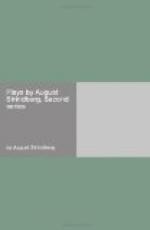I have placed the rear wall and the table diagonally across the stage in order to make the actors show full face and half profile to the audience when they sit opposite each other at the table. In the opera “Aida” I noticed an oblique background, which led the eye out into unseen prospects. And it did not appear to be the result of any reaction against the fatiguing right angle.
Another novelty well needed would be the abolition of the foot-lights. The light from below is said to have for its purpose to make the faces of the actors look fatter. But I cannot help asking: why must all actors be fat in the face? Does not this light from below tend to wipe out the subtler lineaments in the lower part of the face, and especially around the jaws? Does it not give a false appearance to the nose and cast shadows upward over the eyes? If this be not so, another thing is certain: namely, that the eyes of the actors suffer from the light, so that the effective play of their glances is precluded. Coming from below, the light strikes the retina in places generally protected (except in sailors, who have to see the sun reflected in the water), and for this reason one observes hardly anything but a vulgar rolling of the eyes, either sideways or upwards, toward the galleries, so that nothing but the white of the eye shows. Perhaps the same cause may account for the tedious blinking of which especially the actresses are guilty. And when anybody on the stage wants to use his eyes to speak with, no other way is left him but the poor one of staring straight at the public, with whom he or she then gets into direct communication outside of the frame provided by the setting. This vicious habit has, rightly or wrongly, been named “to meet friends.” Would it not be possible by means of strong side-lights (obtained by the employment of reflectors, for instance) to add to the resources already possessed by the actor? Could not his mimicry be still further strengthened by use of the greatest asset possessed by the face: the play of the eyes?
Of course, I have no illusions about getting the actors to play for the public and not at it, although such a change would be highly desirable. I dare not even dream of beholding the actor’s back throughout an important scene, but I wish with all my heart that crucial scenes might not be played in the centre of the proscenium, like duets meant to bring forth applause. Instead, I should like to have them laid in the place indicated by the situation. Thus I ask for no revolutions, but only for a few minor modifications. To make a real room of the stage, with the fourth wall missing, and a part of the furniture placed back toward the audience, would probably produce a disturbing effect at present.
In wishing to speak of the facial make-up, I have no hope that the ladies will listen to me, as they would rather look beautiful than lifelike. But the actor might consider whether it be to his advantage to paint his face so that it shows some abstract type which covers it like a mask. Suppose that a man puts a markedly choleric line between the eyes, and imagine further that some remark demands a smile of this face fixed in a state of continuous wrath. What a horrible grimace will be the result? And how can the wrathful old man produce a frown on his false forehead, which is smooth as a billiard ball?




